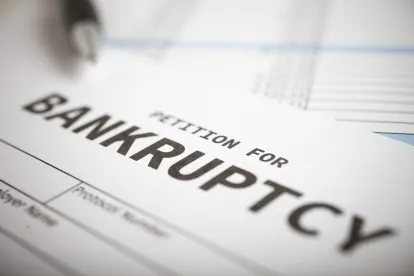Certain licensees of intellectual property are expressly given expanded rights when their licensors file bankruptcy. But what about trademark licensees? Trademarks are not among the defined categories of “intellectual property” for bankruptcy purposes. Nonetheless, are trademark licensees otherwise protected in a licensor bankruptcy? Unfortunately for these licensees, a recent circuit court decision put the brakes on attempts to expand protection to licensees of trademarks.
The question before the First Circuit Court of Appeals in Mission Prod. Holdings, Inc. v. Tempnology, LLC (In re Tempnology, LLC), No. 16-9016, was whether a trademark licensee could take advantage of rights granted intellectual property licensees under Section 365(n) of the Bankruptcy Code. Under Section 365(n), if a debtor rejects an executory contract under which the debtor is a licensor of intellectual property, the licensee may either (a) elect to treat the contract as terminated (i.e., breached), and file a proof of claim for damages flowing from the debtor’s termination of the contract, or (b) retain its rights to use the intellectual property under the contract for the duration of the contract and for any extension periods provided for by the contract. If it elects to retain its rights to the intellectual property, the licensee must continue to make all royalty payments due under the original term of the contract, and any term extensions that the licensee elects to exercise. The debtor-licensor must, upon written request of the licensee, (i) comply with any contractual requirement to provide the intellectual property to the licensee, and (ii) refrain from interfering with the rights of the licensee to the intellectual property.
As mentioned above, trademarks are not included within the listed categories of “intellectual property” as set forth in Section 101(35A) of the Bankruptcy Code. Thus, the question arises whether a trademark licensee can utilize Section 365(n) to continue to utilize the trademark notwithstanding the licensor’s bankruptcy filing.
The combination of Sections 101(35A) and 365(n) has been read to create the inference that Congress did not intend to protect a trademark licensee in the same way in which an intellectual property licensee is protected. However, some courts have rejected this so-called “negative inference” and have held that bankruptcy courts have the authority to permit a non-debtor to retain a trademark license based upon the equities of the case. Moreover, in Sunbeam Prods. v. Chicago Am. Mfg., LLC, 686 F.3d 372 (2012), the Seventh Circuit Court of Appeals rejected the “negative inference” but nonetheless held that a non-debtor’s right to continue to use a trademark license is based upon Section 365(g) of the Bankruptcy Code which provides that a rejection of an executory contract simply constitutes a prepetition breach of that contract — it neither acts as a contract rescission nor termination. Instead, rejection leaves in place the licensee’s right to continue to use the licensed trademark notwithstanding the contract’s rejection.
In In re Tempnology, the debtor had granted the non-debtor licensee a bundle of rights including an irrevocable, fully paid, transferrable license to its intellectual property and a non-exclusive, non-transferable license to use its trademarks. The debtor conceded that Section 365(n) permitted the licensee to retain its licensed rights to the intellectual property, but argued that Section 365(n) did not extend to the trademarks. The bankruptcy court agreed with the debtor, but the bankruptcy appellate panel (the “BAP”) reversed, holding that the rejection of the trademark license agreement did not destroy the licensee’s rights to the trademarks.
The First Circuit reversed the BAP in a divided 2 to 1 decision. The majority rejected the BAP’s reliance on the Seventh Circuit’s Sunbeam decision, holding that Sunbeam was based upon the faulty premise that allowing the licensee to continue to utilize the trademark did not require the debtor licensor to continue to perform under the license agreement:
Effective licensing of a trademark requires that the trademark owner – here Debtor, followed by the purchaser of its assets – monitor and exercise control over the quality of the goods sold to the public under cover of the trademark. Trademarks, unlike patents, are public-facing messages to consumers about the relationship between the goods and the trademark owner. They signal uniform quality and also protect a business from competitors who attempt to profit from its developed goodwill. The licensor’s monitoring and control thus serve to ensure that the public is not deceived as to the nature or quality of the goods sold. … Importantly, failure to monitor and exercise this control results in a so-called “naked license,” jeopardizing the continued validity of the owner’s own trademark rights. (citations omitted)
Thus, the majority held, allowing a trademark licensee to continue to utilize the trademark post-rejection ran contrary to the “principal aim” of Congress in permitting rejection of executory contracts, which was to release a debtor’s estate from continuing obligations that would interfere with reorganization. Instead, the majority held that it was up to Congress to expand the scope of Section 365(n) to include trademarks, most likely through an expanded definition of “intellectual property” under Section 101(35A), holding that “we favor the categorical approach of leaving trademark licenses unprotected from court-approved rejection, unless and until Congress should decide otherwise.”
The First Circuit’s decision in In re Tempnology demonstrates the split of authority among the circuit courts, as well as the lower courts, with regards to the protections afforded trademark licensees in a bankruptcy proceeding. Whether a licensee’s trademark rights are protected upon the licensor’s bankruptcy filing should not depend upon where the case is filed. Either Congress should, as the First Circuit suggested, amend the Bankruptcy Code to clarify the status of trademark rights or the Supreme Court should resolve the circuit split. Either way, clarity is sorely needed.




 />i
/>i

